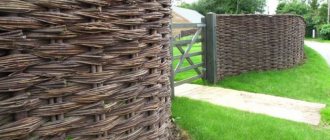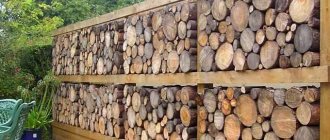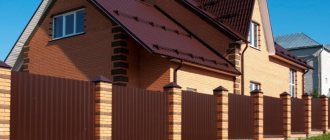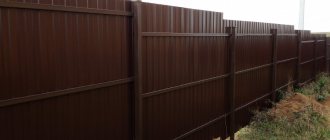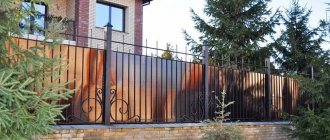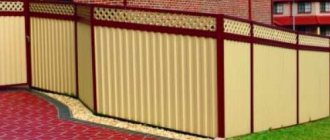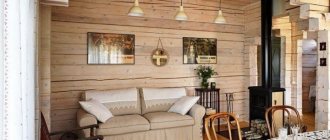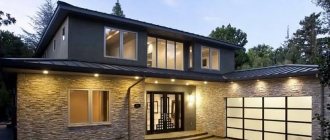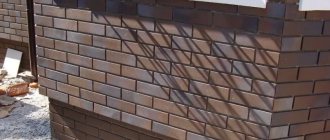A stone fence looks textured and solid if you have managed to realize the potential of this difficult material. In order for a fence made of stones not only to protect the territory, but also to give a respectable appearance to the site, a thorough approach to its creation is required. We'll figure out how to choose a material, which design option to prefer, what you need to remember when building a fence.
Original use of familiar material Source yelpcdn.com
Stone fence: good or not so good
Owners who decide to build a stone fence around the site or in the yard are guided by the following advantages:
- Increasing status. The aesthetics of natural material guarantees a spectacular look to the fence. The fence looks respectable, and this feeling extends to the surrounding space.
- Strength and durability. Structures made of natural stone are resistant to all types of impact, dynamic loads, and atmospheric factors (subject to proper planning and construction). Durability increases if the structure is properly maintained.
- Diversity. Different types of stones are used for masonry; it is easily combined with other building materials (wood, metal, brick). This guarantees an endless variety of designs that fit into any landscape design.
Fence and flower bed in the same style Source na-dache.pro
- Performance characteristics. A stone fence is both environmentally friendly and fireproof, which is not always the case with other options.
- Additional features. The masonry can be used as a support, for example, for a terrace or car parking.
- A decorative fence helps to zone the yard into meaningful parts (for example, it separates a recreation area).
It is impossible not to note the following disadvantages of stone construction:
- Financial expenses. Sometimes a fence can turn out to be budget-friendly if some available material (for example, cobblestones or pebbles) is found in abundance in your area. In most cases, the cost will be high, especially if you need a stone with certain decorative properties.
- The need for a quality foundation. A well-thought-out foundation makes the structure strong and durable, and it also increases the construction budget.
The foundation increases the reliability of a stone fence Source zabor.bz
Artificial stone for finishing
Today there are many options for finishing fences and posts that look very impressive, are not inferior to natural materials in quality and significantly save money. Artificial stone is several times cheaper, and it is much easier for facing work.
Modern technologies for the production of artificial stone provide this building material with durability, strength and a beautiful aesthetic appearance. When properly processed, it tolerates temperature changes, frost and high humidity well. Artificial stone can imitate the relief and color of any natural stone, for example, marble, shell rock or sandstone.
Very beautiful fence decoration with artificial stone
If the cladding is done in a seamless manner, from the outside it will be difficult to distinguish it from natural stone. As a rule, artificial stone looks like rectangular or square tiles. Its outer surface imitates natural stone, while the inner side is smooth.
Tiles do not require special knowledge and skills when carrying out finishing work. It can be used for finishing stone or cement fences or combined fence posts.
The stages of finishing work are no different from finishing with natural stone, but everything is much easier and simpler. You don't need to size it or worry about additional fasteners. With proper work and proper subsequent processing, the fence will serve for a long time without losing its attractiveness and functionality.
What are they built from?
For construction, both natural and artificial materials are used, choosing them for financial and aesthetic reasons. The following stones are often chosen (in order of increasing cost):
- Cobblestone. A cobblestone fence is one of the most inexpensive ways to fence off an area. Cobblestone (or boulder stone) comes from high-strength rocks and has a rough, rough surface. The palette does not please with variety - gray and reddish-brown shades, which, however, easily fit into any landscape.
- Pebbles. Rounded rock fragments are found on the sea coast (beach) and along the banks of mountain rivers. Pebbles are often used for decorative purposes, as their palette is quite diverse. It is quite problematic to build a fence out of it entirely, but it can be combined with other materials (for example, brick), used to strengthen the corners of a fence or in gabion nets.
Natural stone with brick trim Source na-dache.pro
- Dolomite. A mineral with a high content of calcium and magnesium oxides, with a glassy luster that varies from matte to pearlescent. Shades – colorless, white; if there are impurities of iron or clay, then they are yellowish or brown. Dolomite is quite fragile, so a fence is not built from it, but is used in the form of slabs for cladding.
- Limestone (variety: shell rock). A common sedimentary rock, a relative of marble. It has no shine, the usual color is light gray. Impurities add variety: there are white, almost black, pinkish, light yellow and other varieties. Limestone is widely used in construction, including for the construction of fences.
- Sandstone. A homogeneous or layered sedimentary rock dominated by quartz. There is a wide variety of sandstones with different chemical compositions, some of them are used in construction as walling and facing materials. Sandstones with a siliceous and carbonate base have the best characteristics.
Fence made of limestone blocks Source wikimedia.org
- Rubble stone. Rubble is fragments of rocks (sandstone, limestone, dolomite) remaining in the field after development. The material has different sizes and weights; according to the extraction method, flagstone, bedded or torn rubble are distinguished. For laying a fence made of rubble stone, material is used in the form of a brick, for finishing - in the form of tiles.
- Artificial stone (from fiber-reinforced concrete). Successfully imitates different types of natural materials and competes with natural analogues. It is durable, lightweight, inexpensive, and is used both for cladding the entire structure and individual parts (for example, pillars). The market offers material with smooth, rough, torn texture of any color. Ultraviolet resistant pigments are used for coloring.
Classification by type of stone processing for fence
Natural stones are extracted from rocks and, accordingly, are sorted by type of degree of processing. There are three main types:
- Rude,
- Average,
- Polished.
Rough stone needs pre-processing at the construction site - it is lightly trimmed, smoothing out sharp corners. Laying with rough-cut stone is a long and rather problematic process due to the selection of elements that match each other. In terms of price, of course, this type of processing will be the most budget-friendly.
Medium-cut stone is most often used for the construction of fences - it is this type of processing that has the golden mean in terms of “price - quality”. Beautiful masonry made from it, of course, is available only to specialists, but in terms of work it is simpler than rough ones. At the place of installation it is enough to only lightly polish it.
Polished natural stone is the most expensive of this segment of building materials, this is natural - as it is due to its type of processing. After extraction, such stone is sorted by approximate size and carefully polished using grinding equipment. Its appearance is most attractive and it does not require any additional processing.
Fences made of polished stone are quite rare, since the cost of such a structure will be decent. Finishing or partial masonry made of polished stone is more common. Visually, a fence made of this type of material looks even and smooth, and goes well with forged and other decorative elements.
Varieties
Solid fences made of natural stone are quite rare, mainly where it is abundant in natural conditions. Usually the fence is laid out of cut stone: cobblestone, dolomite, limestone. Granite is quite rare, due to its high cost.
Using two-color material Source stroyfora.ru
For other regions, this is an expensive pleasure, and they prefer to keep them low. Much more often, a combination of stone and other materials is used to build a fence. The following design options are common:
- Deaf (solid). Consists of stone pillars, the spans between which are filled with brick, stone, or a combination of both; Concrete panels are possible. Often they do cladding (for example, with rubble); it can be continuous or partial (along the foundation, along the pillars).
- Combined. Combinations with other materials are used; A popular option is a fence made of stone and wood. Brick may be present, often in combination with forged elements.
- Sectional. To create a fence, corrugated pipe, steel rod, corrugated sheeting, and wooden panels are used. The stone is used for cladding foundations and pillars.
- From gabions (bulk). The fence is made from a frame (welded mesh) in the form of blocks, which are filled with stones. Pebbles are best suited for the role of filler: durable, aesthetic, frost-resistant, with minimal water absorption.
Combination of wood and gabions in a modern style Source rackcdn.com
See also: Catalog of companies that specialize in the construction of fences and railings
What is needed to build a fence?
First of all, we select the material for the construction of our fence. We can lay out rubble or hewn stone. Hewn stones are stones with specific dimensions and a specific shape. They are most convenient to use for masonry. If you have no experience in stone laying, it is definitely recommended to build pillars from hewn elements.
Various stones
Rubble stone has an irregular shape and allows the construction of structures with a unique design. It is from this material that it is recommended to lay out the spans - it will turn out very beautiful and original.
Rubble stone (cobblestone), large pieces of various shapes with an edge length of 50-350 mm, obtained from dense rocks of glacial origin
Among the most popular materials for laying stone fences are limestone and dolomite, as well as granite and sandstone.
Dolomite
We purchase or extract the required amount of the selected stone ourselves, and then prepare the following working tools:
- a concrete mixer or a container for preparing the solution manually;
- roulette;
- shovel;
- Master OK;
- level;
- rods and cord for marking.
Preparation and design
Construction of a fence made of natural stone is a multi-stage and labor-intensive process. The structure turns out to be massive, so construction requires some preparation. The work includes pouring a strip foundation, the width and depth of which depends on the characteristics of the soil and the topography of the site.
For pouring you will need reinforced concrete, which means you cannot do without a concrete mixer. Also at different stages you will need the following tools:
- Performing markings. Pegs, cord, tape measure, fittings. When marking and erecting masonry, it is convenient to use a laser level, but you can get by with a plumb line and a standard building level.
- Foundation. Shovels (scoop, bayonet), tamper, several buckets.
- Stone laying. Shovel, trowel or trowel.
Materials you will need:
- Cement (M300-400), crushed stone (20-30 mm), sand (up to 5 mm).
- Reinforcement (8-12 mm), steel pipes with a thick (at least 3 mm) wall, 3.5-4 m long.
Parameters of a stone fence with a foundation Source stroyfora.ru
- Materials for decorative finishing.
- The formwork is constructed from semi-edged boards.
The plan is carried out in relation to the area, to scale, in compliance with the dimensions of the structure. Dimensions (including the height of the fence and gate), decorations, and additional details are specified individually, based on personal preferences, style, budget and practical need. On average, the height of the enclosing structure is set within 2-2.5 m, decorative options inside the site are smaller.
Structurally, the fence consists of spans, the size of which is determined by supporting pillars. A profiled metal pipe is suitable as the basis for the supports. To fill the spans, masonry is used or sections made of another material are installed. The pipes and foundation are finished with stone.
A fence made of stone and wood on an uneven area Source na-dache.pro
How to determine the boundaries of a territory
Before you make a stone fence, be sure to find out where the boundaries of your property are. Perhaps they are not where you thought, which is fraught with the demolition of a new building, or disagreements with neighbors.
Note! In the future, it will no longer be possible to change the trajectory of the fence without its complete destruction. Invited surveyors can help you in this matter. Border delineation is one of the services they provide.
Have you already clarified the boundaries of your site? Now you can start measuring the length of the sides, as well as sketching the future structure. Do not forget to mark on your sketch the height of the fence, the places where you will have entrances (wicket, swing or other gates). The height of the fence is selected individually. If you want a high fence, then the optimal length in height is from 2 m to 2,200 cm. Next, proceed to marking the required number of pillars for support. To maintain the strength of the structure, a certain length of spans per number of supports is required: approximately 1 pillar per 2.5-3 meters of length. The maximum length of 3.2 meters is no longer recommended.
Foundation construction
For a massive, elongated structure, dense, strong soil and a low groundwater level are considered successful. In this case, a sufficient solution would be a strip shallow foundation made of monolithic reinforced concrete. If the site has complex soils, the base is selected individually; Piles may be needed. The work is performed in the following sequence:
- Site preparation. The area is cleared, plants are removed, roots are pulled out. The soil is leveled and markings are applied: pegs are driven along the contour and the cord is pulled.
- Digging a trench. The depth of the trench for a shallow foundation depends on freezing, it is 60-80 cm. The width is set depending on the width of the column, 40-50 cm. The foundation is made continuous, it should not be interrupted under the gate or wicket.
- Preparing to pour concrete. Place a sand cushion (at least 5 cm) and compact it well. Formwork is assembled from boards, which can be replaced with available materials: plywood, boards.
Fence diagram with gates and wicket Source dizainexpert.ru
- Installation of the frame. A frame of two meshes is laid at the base. The first is laid on a sand cushion, the second should be located 0.4-0.5 m below the surface. If working reinforcement with a thickness of 8-10 mm is used, then 6 mm is sufficient for transverse connections.
Reinforcement is a prerequisite for a strong foundation for a stone fence. If you neglect its parameters, the fence may crack over time. It is useful to supplement the frame with rods with a diameter of 10-12 mm or pipes of small diameter (depending on the mass of the structure).
After the frame is installed, the trench is concreted. For optimal results, it is important to choose the right, warm, but not hot season. The first day the tape is protected from rain, then from the sun and wind. Concrete reaches brand strength after 28 days, but the formwork is removed earlier, usually after two weeks. They begin to lay out rows when the foundation reaches 75% strength.
Concrete mortar in formwork Source svoizabor.com
Step-by-step guide to installing a DIY stone fence
A stone fence is erected in the same manner as a brick structure. Therefore, the sequence of steps is similar.
A diagram of the future fence is drawn up on a sheet of paper, and calculations of material consumption are carried out.
Calculation of the amount of raw materials
To obtain an indicator of the load of supports on the base, it is necessary to multiply its volume by the weight of the materials used.
When calculating the number of sections, it is important to take into account the length of the gate and wicket. For gates, the average distance between posts is 3.6-4.2 m, wickets - 1.8-2.2 m. We get an average value of 5.9 m. We subtract this indicator from the total length of the fence, and we get the length of all sections.
We divide the length of the sections by the step between the supports (2 – 2.5 m) and the result is the number of spans. We multiply the consumption of stones in one section by their number, we obtain the required volume of material.
Preparation of materials and tools
The required list for work is as follows:
- cord or rope for marking;
- cement grade M300, M400;
- crushed stone of medium fraction;
- reinforcement bars with a diameter of 0.8 – 1.2 cm;
- sand with a fraction of 0.15 – 5 mm;
- semi-edged board (for formwork);
- thick steel pipe with a diameter of 50 – 80 mm;
- grinder and metal circle;
- wood saw;
- level;
- plumb line;
- shovels;
- tamping;
- welding machine, mask, electrodes;
- buckets;
- nails;
- roulette;
- Master OK;
- concrete mixer or construction mixer.
Photo: working and measuring tools for laying stone
Facing materials are chosen at the discretion of the owners.
Marking
The building site is cleared of vegetation and debris. The top layer of soil up to 5 cm is removed.
Wooden pegs are driven in at intervals of 2–2.5 m in the places where the supports are installed. It is better to start from the gate with the gate. A cord is pulled tightly between the pegs.
Foundation
It is recommended to build stone fences away from buildings, since the large weight of the structure will cause strong subsidence on adjacent areas and there is a risk of changing the quality of waterproofing.
If the site is subject to flood waters, it is necessary to equip the site with a slope for drainage to avoid the accumulation of excess moisture.
For uneven terrain, where there is loam under the fertile layer, it is recommended to choose a shallow belt with bored piles as a foundation or lay out FBS blocks in steps.
As for the depth, for a stone fence an indicator of at least ⅖ of the height is taken.
When the fence height is over 2 m, the tape is reinforced by tying reinforcement with pipes for posts and horizontal membranes.
Photo: installation of formwork for pouring tape
The minimum trench depth is from 55 to 70 cm.
On sandy soils, the bottom is lined with plastic film to prevent laitance from leaking deeper. The top is filled with crushed stone and sand and compacted thoroughly.
After this, you can fill the tape with rubble filler or simply reinforce the trench and fill it in layers with concrete mortar. The last option is more preferable.
Thematic material:
- Types of strip foundations
- How to properly pour a foundation for a fence
To speed up the work, it is better to use a concrete mixer for mixing and pouring. Installation of formwork is required.
Laying pillars
Before starting, the wild stone is thoroughly washed in water. Cobblestones with a smooth surface are notched for better adhesion to other elements.
A wooden box up to 40 cm high is placed on a metal pipe-rack and secured with pre-installed reinforcement bars.
Link to article: “how to install a metal fence post”
Inside it, stones are laid in such a way that each element rests on several points at once. Areas of material in contact with concrete are coated with latex glue.
The masonry mortar is mixed from cement, clean sand, and PVA glue in a ratio of 1:3:0.25.
The laid elements are spilled with the mixture. Let it dry for a day. After which the formwork is removed.
If the vertical is maintained, then move the box higher. This is done until the pillar reaches the desired height.
For the top row, stones with a smooth surface are selected. An alternative is to complete the stone pillars with porcelain tiles next to them.
Laying sections
Creating a solid stone wall is possible without preliminary installation of pillars. For reinforcement, a reinforcement frame or brick base is laid inside.
Before laying, the material is cleaned of dirt and elements are selected.
The most popular are plank or horizontal flat.
Upon completion, it is important to pay attention to finishing the seams and filling the resulting voids between the stones with mortar.
Finishing and decorating a stone fence
Since the stone absorbs cement laitance well, after completion of the masonry, the outer part of the fence must be washed to remove dirt.
To protect from moisture, the finished sections are coated with silicone varnish and facade primer.
To obtain an interesting color, structural plaster is used.
Crushed granite is applied on top, making interesting mosaics or granite chips.
Laying pillars
The fence should be as smooth as possible. To do this, it is important to carefully mark the distance between the pillars, and in the places where they are located, release the reinforcement (4 rods 12-14 mm thick). If heavy (for example, forged) gates are planned, the reinforcement is made thicker. The pillar is laid in two ways:
- Without formwork. 4 corner stones are placed on the mortar according to the markings, carefully aligning their relative positions. Then the gaps are filled, selecting stones of a suitable size, taking into account the thickness of the seams (1.5 cm). Then they fill the gaps with concrete and wait for the first row to set. The second and subsequent rows are placed with ligation of the seams (there is no seam above the seam), the process is controlled by a level.
- With formwork. To simplify the work, sliding formwork is used. It is built according to the dimensions of the pillar, which ensures its ideal dimensions. The formwork is filled with tiers of stones held together with mortar and left to gain strength. Then it is moved higher, and the space between the stones of the finished part is sealed with a cement-sand mixture.
- At the end, the foundation and pillars are faced.
The pillars are installed on the foundation first Source nikastroy.ru
Use of ornamental plants
In addition to various materials, shrubs and trees can be used to create fences. The height, density and protective functions of hedges depend on the parameters of the selected plants. They can be decorative, no more than 50 cm high, or functional, consisting of 2-3 meter trees.
Beautiful, but not always practical
VIDEO: Beautiful fences for your home
Fences for private houses
Beautiful fence options
Span masonry
Depending on the project, masonry is carried out or spans are installed. In the first case, before laying out a fence made of flagstone or rubble, the span sections are marked. They will be narrower than the pillars: if the width of the pillar is 40 cm, then the span is 30 cm. The wall is evenly shifted on both sides by 5 cm; in this case, the longitudinal axis of the fence remains the axis of symmetry.
The rows are laid out with bandaging along a stretched cord, starting from the outermost stones. For the final row, flat stones are selected so that the top is even. After completion of the masonry, the joints are done. At the last stage, protective caps and visors are installed (if provided for in the project).
Poles with protective caps Source expo-stolichny.rf
Finishing work
Above, we have already discussed the procedure for performing preparatory work during the construction of a fence. Speaking of the final phases, you need to cut the seams. To do this you will need a tool:
- metal brush;
- guillemot;
- suture trowel;
- sponge.
We have already discussed above how to fill seams using a bag of mortar. Jointing is done 3–4 hours after filling . Otherwise, the mass will begin to harden and the formation of joints will be problematic.
First, the surface of the stones must be cleaned with a brush to remove traces of the solution. After this, you need to form the seams using a trowel or scraper.
To give the fence its final look, it must be washed. Hard-to-remove traces of masonry mortar can be eliminated using a solution of hydrochloric acid at a concentration of about 30% and a sponge. The operation must be performed with rubber gloves. Otherwise, chemical burns cannot be avoided.
The final operation in the construction of a fence is the installation of caps on the posts and tops on the fence spans. This will prevent water from getting inside the masonry. Otherwise, when it freezes, the entire structure may be destroyed.
An excellent combined fence design solution
Briefly about the main thing
A fence made of stones is a reliable and durable fence, a beautiful detail of any landscape design. It is built from inexpensive rocks of different origins: sandstone, cobblestone, shell rock, limestone, pebbles. The design of fences is pleasantly varied, from options with solid masonry to combinations with wood and metal.
For the strength and durability of a structure, the quality of the foundation is important; it is laid taking into account natural factors and is necessarily reinforced. When the solution in the trench becomes strong, stones are laid, selecting them according to size, taking care to bandage the seams. At the final stage, the space between the pillars is filled, decorative finishing is performed, and lighting is installed.
TOP 9 materials for enclosing structures
To build fences around your home area, you can choose wood, brick, natural or artificial stone, metal and concrete structures. Combinations of several materials also look organic.
There are a lot of materials that can be used
Tree
Wooden structures are a traditional type of fence for private households, which have protected estates since ancient times. Their popularity is due to the availability and low cost of the material, as well as the variety of options. You can use coniferous or deciduous wood as raw materials.
Wood is a great choice
Examples of wooden fences
1 Pletni. To make it, you will need willow twigs or other plants, which are cleaned or left in their original form. Such fences are usually used to divide an area into zones, since they do not provide reliable protection and require constant updating. The fences look harmonious with wooden houses in a rustic style.
Wattle using boards
2 Picket fences. You can build it from wooden planks, which need to be fixed on horizontal crossbars. A gap of different sizes is left between adjacent elements, and their tops can have different shapes.
The gap in the picket fence is at your discretion
3 Fence made of logs or timber. They can be positioned horizontally or vertically. The diameter of the logs is selected in accordance with the massiveness of the house, which must also be built of wood.
Timber fence
Unlimited scope for imagination is provided by a fence made of boards. Depending on your wishes, it can be solid or imitate weaving.
Lattices, assembled with large gaps between the boards, are used in the form of sections for fencing. They can also serve as a basis for climbing flowers or plants planted around the perimeter of the site.
Imitation of weaving from boards
If you want to preserve the natural texture of wood, avoid using paints and varnishes that form a dense layer after application. In this case, impregnation or a special varnish for outdoor structures is better suited.
Classic combination of wood and stone
Brick and stone
More durable materials that you can use to build fences are brick and natural stone. They allow you to build reliable and durable structures, but require a foundation. Basalt, granite or porphyry are used for fences.
Durable granite fencing
The luxury of stone allows you to avoid complex structures by constructing fences of simple shapes. Their beauty is enhanced by bright flowers and evergreens. Cracks, chips and other defects create the effect of aged structures, which are ideal for buildings with similar facade designs.
Luxurious stone fence
To save money, you can replace natural material with artificial stone or small cobblestones. An interesting option for fencing are structures made of posts and mesh filled with pebbles or gravel. Such fences resemble gabions and harmoniously combine with the deliberately rough texture of the pillars and facades of the house.
Common types of pebbles
Brick fencing is the best option for owners of cottages lined with the same material. Such fences will reliably protect your territory from prying and prying eyes. To avoid monolithic and ordinary perception, brick structures are decorated with turrets, arches and other decorative elements.
For lovers of intricate stone and brick fences
Fences that are constructed using a checkerboard pattern look interesting. In addition, this method allows you to save material and reduce the cost of constructing a fence.
Concrete structures
As an alternative to massive structures made of brick or stone, you can use ready-made concrete structures. They are sections of different sizes and shapes that are fixed in the grooves of the pillars. The front surface of concrete panels can have different textures: smooth or rough, glossy or matte.
Ready-made concrete structure
You can buy both tinted and unpainted sections and choose the appropriate shade taking into account the architectural and color schemes of the house.
Another option for concrete fencing is block construction. You can choose a material with the texture of natural stone, wood, or with a fancy surface pattern. Supplemented with posts, caps and other decorative elements, a concrete fence will decorate a dacha or city house.
Concrete block structures are reliable and strong
If you want your concrete fence to be indistinguishable from wooden structures, carefully select paint compositions and avoid bright, saturated colors.
Metal
Metal fences are strong and durable structures. Thanks to painting with special compounds, they are resistant to corrosion and do not deteriorate over time under the influence of moisture. The variety of metal shapes allows you to create simple and complex designs.
A modern metal fence always looks trendy
From profile pipes
The simplest option is a fence, the sections of which are made of profile pipes secured to each other by welding. You can choose an option with a different combination of metal pieces formed into a single pattern. Such structures look especially impressive next to a house whose cladding is made of brick or stone.
Profile pipes that are attached to each other
Fences made from profile pipes do not provide complete privacy due to the many gaps between the elements. To protect from prying eyes, metal sections can be combined with profile sheets or boards. Privacy can also be achieved using polycarbonate of different colors and shades.
We supplement the design with polycarbonate
From a picket fence
No less popular due to their availability and ease of maintenance are fencing made of profiled metal sheets or picket fences. Structural elements are painted at high temperatures under pressure, so they retain their brightness and color saturation for a long time. The decorative layer also performs protective functions: thanks to the paint coating, your fence will be resistant to moisture and will not require replacement for a long time.
Stable and painted picket fence
Profiled sheets
For fencing construction, you can purchase profiled sheets, the front surface of which imitates materials of different textures. Sections with the texture of stone or wood of walnut, oak, cherry and other species are available for sale. Thanks to this finishing, the fence around your house will be unusual in decor and durable, since metal has a long service life.
Profile sheets for fence
A metal picket fence is made from profiled sheets in the form of lamellas of a certain width. The planks are fixed with a small gap on horizontal crossbars parallel to each other. They can be placed both vertically and horizontally.
Option for vertical arrangement of corrugated sheets
Metal sheets
An interesting type of fencing is represented by metal sheets with carved patterns or perforations. They are fixed to poles and create the effect of an openwork and weightless structure.
To make a fence made of profiled sheets or a metal picket fence look like a single monolithic structure, use posts, crossbars and fastening elements whose color matches the color of the base material.
We combine colors in one design
An elite version of metal fencing is forged structures, which are characterized by high cost and spectacular appearance. The more complex the pattern, the more expensive each section of the fence will cost you. If you want to save money, you can use welded structures made from profile pipes, complemented by forged inserts and patterns.
Corrugated sheeting with forged inserts and patterns
Imitation brick for exterior fence finishing
The building materials market offers a large selection of decorative bricks with a variety of colors and textures.
Recently, polymer panels imitating brick pillars (PIX panels) have become especially popular. They are made from high-quality polypropylene, which is resistant to environmental influences.
Advantages and disadvantages of PIX panels
Finishing with PIX panels to imitate brick
PIX panels, compared to other facing materials, have a wide range of advantages, for example, environmental friendliness and fire safety.
Other benefits
- They are lightweight and do not require any tools other than a screwdriver for installation.
- They do not require protective treatment or special care methods. Dirt from their surfaces is removed with a brush and soap solution.
- They have a texture and color scheme that accurately replicates the appearance of brick and masonry.
- Does not require pouring a foundation.
- They are installed much faster than other finishing materials.
- 5 times cheaper than brick.
- When carefully dismantled, they can be reused.
- They do not fade in the sun, do not peel and have a long service life (at least 5 years).
PIX panels can be mounted on a ready-made fence. They can also be painted in any color, which does not affect performance in any way.
The disadvantages of the new finishing material include insufficient mechanical strength and the lack of commercially available elements for arranging corner posts. Such supports must be cut out yourself from two PIX panels.
Imitation of brick for exterior finishing of a fence using PIX panels does not strengthen the structure of the fence, it only performs decorative functions.
Specifications
PIX panels are U-shaped and come in different sizes.
Industrially produced PIX panels are U-shaped and have the following parameters:
- length – 380 mm;
- width – 300 mm;
- depth – 150 mm;
- wall thickness – 20 mm;
- weight – 0.5 kg;
- operating temperature range – -40… + 60°С.
On sale you can find PIX panels with dimensions of 38x15x29.6 cm.
PIX panels are packed in 12 pcs. total weight 6 kg.
Color range: brown, yellow, cinnamon, chocolate, ivory.
How to decorate the fence?
Following modern trends, it is impossible to imagine a private home without a fence.
The appearance of which forms the general opinion about the thriftiness of the owners. The use of modern decorative finishing materials helps create a certain look for the entire architectural ensemble, improving the appearance of the entire site. This is why it is so important to line the fence around the house.
There are cases when the appearance of the fence near the home area is made from scrap materials; as a result, such a reliable “structure” may be uneven, skewed, or a completely reliable fence may turn out to be fragile. No matter how “reliable” the fence is, of course, the owners are looking for ways to correct the situation, and at the same time improve the fence around the house.
Just a few years ago you could see chain-link fences and wooden fences. Gradually, fashion moved to more affordable finishing materials - such as corrugated sheets, there are inventors who make wicker fences.
Now everything has changed. Fences are built securely, made of brick or foam block. Even during the construction process, the owners already know what they want to see on their site and what the fence should be like, what it should be built from and how it should be finished.
Decorative finishing of a fence is a task that can be solved in various ways, each of which has both advantages and certain disadvantages. Every day, more and more requirements are placed on the decorative finishing of fences, which must meet the overall appearance of the site, the surrounding landscape, and be aesthetically pleasing.
Some finishing materials look attractive after manufacturing or installation, and in some cases, the issue of additional finishing of the fence is acute. For example, when the fence is made of corrugated board or siding, it looks quite aesthetically pleasing, but if the fence around the house is made of reinforced concrete, the overall appearance of the area looks rather dull. The same applies to old but quite strong fences, which have already become “old” with time, but are still quite a reliable structure.
